If a flood has struck your home, it’s important to take the necessary steps to clean and dry out the affected areas as soon as possible. One of the most important spaces is the basement, which can often take on a lot of water during a flooding event. In this post, we’ll show you how to clean concrete basement floor after a flood using a few simple steps. Let’s get started!
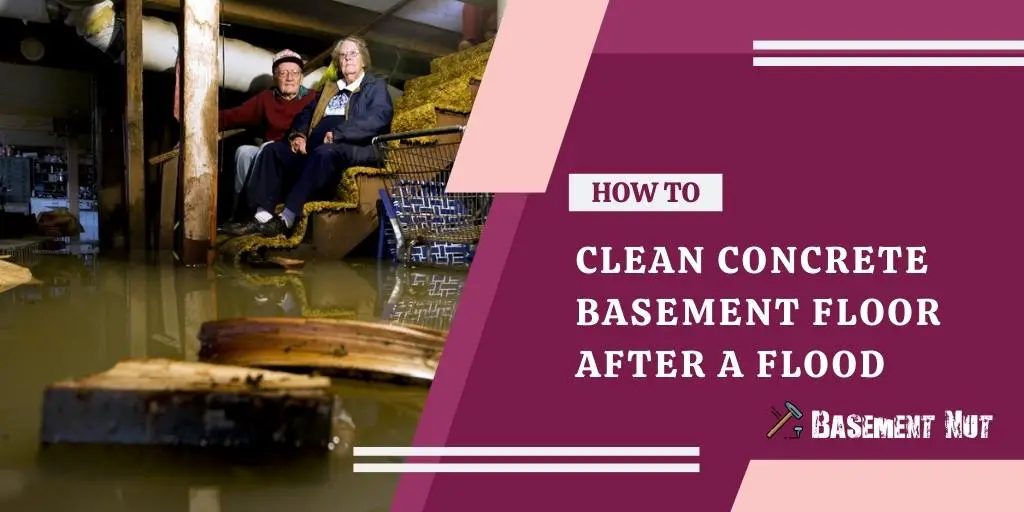
What Causes Basement Flooding?
There are a few reasons your basement may flood during a heavy rainstorm or other water events. The one most likely to cause flooding is a failed sump pump. Sump pumps are designed to remove water from the basement and keep it from accumulating, but if they fail, water can quickly rise and cause flooding. Another cause of basement flooding is a clogged or damaged sewer line. This can cause sewage to back up into your home through the drains, resulting in a nasty and dangerous mess.
Additionally, foundation cracks can allow water to seep into the basement, causing flooding. The other major cause of basement flooding is heavy rains or other water events that overwhelm the drainage system around your home. Lastly, melting snow can also lead to basement flooding.
Why It’s Important to Clean Concrete Basement Floors After a Flood?
Cleaning your concrete basement floor after a flood is important for several reasons. First, it will help prevent mold and mildew growth, which can cause serious health problems. Additionally, it will help to remove any debris or contaminants that may have been brought into your home by the floodwaters.
Another reason to clean your basement floor is to prevent rust and other damage to any metal objects or appliances that may be stored in the basement. Finally, cleaning the floor will help restore your basement to its pre-flood condition and make it more habitable.
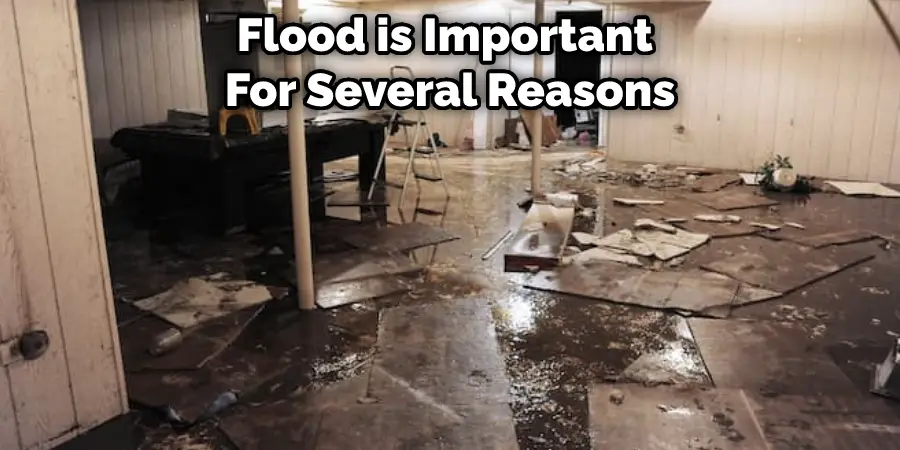
Some Easy Ways How to Clean Concrete Basement Floor After a Flood
1. Remove All of the Water
The first step in cleaning your concrete basement floor is removing all the water. This is because standing water can lead to mold, mildew growth, and damage to the floor itself. You can do this by mopping up any standing water or using a wet/dry vac to suck up the water.
First, mop up any standing water with a clean, absorbent cloth. Then, the wet/dry vac is used to suck up any remaining water. Be sure to empty the vac frequently to avoid damaging the floor. If there is a lot of water, you may need to rent a sump pump to remove the water quickly. Avoid using a regular vacuum cleaner as it can damage the floor.
2. Remove Any Mud or Debris
Once all the water has been removed, you’ll need to remove any mud or debris that may have been left behind. This is important because it can lead to mold growth and damage the floor. The best way to remove mud and debris is with a shovel and broom.
First, use the shovel to remove as much of the mud and debris as possible. Then, sweep up the remaining debris with a broom. Be sure to dispose of the mud and debris properly to avoid attracting pests. If there is a lot of mud and debris, you may need to rent a power washer to remove it quickly. Avoid using a regular vacuum cleaner as it can damage the floor.
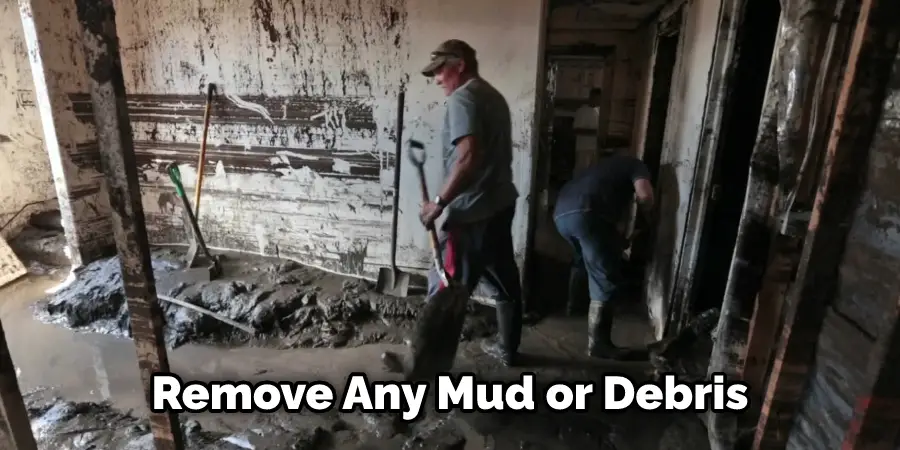
3. Remove Any Mold or Mildew
Once all the water has been removed, and the floor is dry, you’ll need to remove any mold or mildew that may have formed. Mold and mildew can cause serious health problems, so removing them as soon as possible is important. The best way to remove mold and mildew is with a bleach solution and water.
First, mix one cup of bleach with one gallon of water. Then, apply the solution to the affected areas using a sponge or cloth. Let the solution sit for at least 15 minutes before rinsing it off with clean water. Be sure to ventilate the area while you’re working to avoid inhaling the fumes.
4. Clean All Surfaces
Once all the mold and mildew have been removed, you’ll need to clean all surfaces to remove any contaminants that may be present. The best way to do this is with a mild detergent and water. First, mix together a mild detergent and water.
Then, apply the solution to all surfaces using a sponge or cloth. Be sure to scrub any areas that may be contaminated with mold or mildew. Rinse the area with clean water and allow it to air dry. If you’re cleaning a large area, you may need to rent a power washer to remove the detergent and water quickly.
5. Clean Any Metal Objects or Appliances
If you have any metal objects or appliances stored in your basement, you’ll need to clean them to prevent rust and other damage. The best way to clean metal is with vinegar and water solution. First, mix together one part vinegar and one part water.
Then, apply the solution to all metal surfaces using a sponge or cloth. Be sure to scrub any areas that are rusty or dirty. Rinse the area with clean water and dry it off with a clean cloth. Avoid using a regular vacuum cleaner as it can damage the metal.
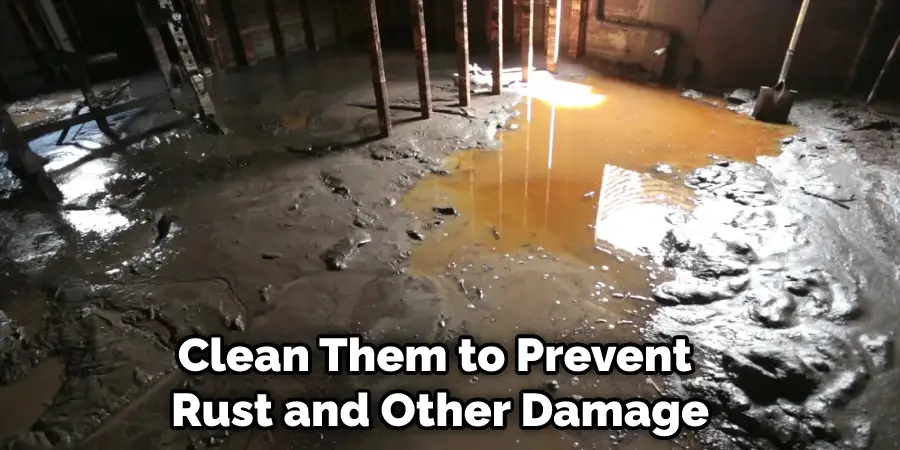
6. Disinfect All Surfaces
Once all surfaces have been cleaned, you’ll need to disinfect them to kill any bacteria or viruses that may be present. The best way to disinfect surfaces is with a bleach solution. To make a bleach solution, mix one-part bleach with nine parts of water.
Once mixed, apply the solution to all surfaces using a sponge or mop. Allow the solution to sit for several minutes before rinsing it off with clean water. You can also use a commercial disinfectant or an EPA-registered disinfectant. Always follow the manufacturer’s instructions when using any disinfectant. Avoid using any cleaning products that contain ammonia. Ammonia can be a health hazard, and it can also damage some types of flooring.
You Can Check It Out To Seal Basement From Bugs
7. Dry Out the Basement
Once all the surfaces have been cleaned and disinfected, you’ll need to dry out the basement to prevent mold and mildew from forming. The best way to do this is with a dehumidifier. Place the dehumidifier in the center of the room and turn it on.
Be sure to empty the water reservoir as needed. It would be best if you also opened any windows and doors to allow air to circulate. If possible, place a fan in the window to help circulate the air. Allow the basement to dry for at least 24 hours before using it again.
8. Repair Any Damages
If there are any damages to the walls, floors, or ceiling, you’ll need to repair them before using the basement again. If the damage is minor, you may be able to repair it yourself. Use a patching compound to fill in any holes or cracks. First, clean the area with a sponge or cloth. Then, apply the patching compound to the area using a putty knife. Be sure to smooth it out so it’s level with the surrounding surfaces. However, if the damage is extensive, you may need to hire a professional.
You Can Check It Out To Clean Water Damaged Carpet
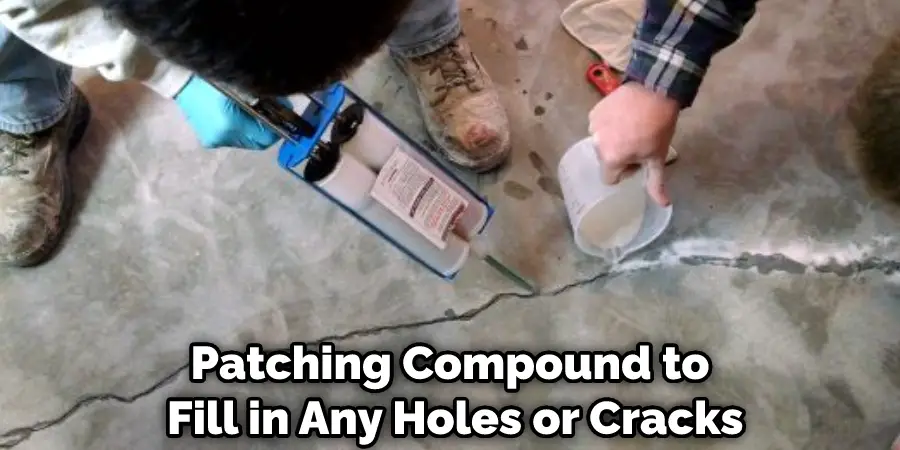
Tips and Warnings on How to Clean Concrete Basement Floor After a Flood
Tips:
- Be sure to wear the proper safety gear while cleaning, including gloves, masks, and eye protection.
- Use a floor brush or broom to remove any debris from the surface of the concrete.
- If there is standing water, use a wet/dry vacuum to remove it.
- Mix a solution of 1 part bleach to 10 parts water and use it to scrub the concrete floor.
- Rinse the floor with clean water and allow it to dry completely.
Warnings:
- Be sure to ventilate the area while cleaning and avoid skin contact with the bleach solution.
- Never mix bleach with other cleaners, as it can create dangerous fumes.
- Avoid using power washers as they can damage the concrete.
- Never use a steam cleaner on concrete, as it can cause the surface to become spongy.
- If mold is present, consult with a professional before attempting to clean it yourself.
- Always test the bleach solution in an inconspicuous area first to ensure it will not damage the concrete.
You Can Check It Out To Does It Cost to Paint a Basement Floor
How Much Does It Cost to Clean a Concrete Floor After a Flood?
The cost of cleaning a concrete floor after a flood will depend on the severity of the flooding and the extent of the damage. If the flooding is minor and there is only light staining or dirt, you may be able to clean it yourself for free.
However, if the flooding is severe and there is extensive damage, you may need to hire a professional. The cost of hiring a professional will depend on the area’s size and the damage’s extent. However, you can expect to pay anywhere from $50 to $200 for professional cleaning services.
You Can Check It Out To Seal Outside House Foundation
Conclusion
So there you have it! Now you know how to clean concrete basement floor after a flood. Follow these steps, and you’ll have your basement back to normal in no time. You can get through this tough time with a little elbow grease and some patience. Be sure to take precautions and always wear the proper safety gear. Good luck!
You Can Chack It Out Build a Basement Under an Existing House
